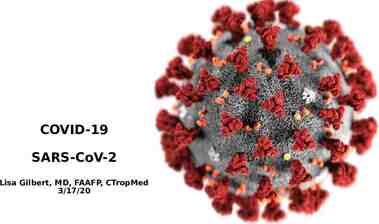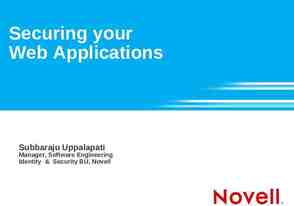Security at different layers Link layer: WEP
37 Slides418.50 KB
Security at different layers Link layer: WEP / 802.11i Application layer: PGP Transport layer: SSL Network layer: IPsec IPsec approach: HTTP/SMTP/IM TCP/UDP/ICMP IPsec IPsec can provide security between any pair of network-layer entities (eg, between two hosts, two routers, or a host and a router). 1
IP Security IP datagrams have no inherent security IP source address can be spoofed Content of IP datagrams can be sniffed Content of IP datagrams can be modified IP datagrams can be replayed IPSec is a method for protecting IP datagrams Standardized by IETF: dozens of RFCs. Only sender and receiver have to be IPsec compliant Rest of network can be regular IP 2
What is confidentiality at the network-layer? Between two network entities: Sending entity encrypts the payloads of datagrams. Payload could be: TCP segment, UDP segment, ICMP message, OSPF message, and so on. All data sent from one entity to the other would be hidden: Web pages, e-mail, P2P file transfers, TCP SYN packets, and so on. That is, “blanket coverage”. 3
Virtual Private Networks (VPNs) Institutions often want private networks for security. Costly! Separate routers, links, DNS infrastructure. With a VPN, institution’s inter-office traffic is sent over public Internet instead. But inter-office traffic is encrypted before entering public Internet 4
Virtual Private Network (VPN) IP header IPsec header Secure payload IP er ad he Secur e paylo ad Public Internet salesperson in hotel ec IPs der a he IPsec heade r laptop w/ IPsec IP heade r re cu Se load y pa Router w/ IPv4 and IPsec IP er ad he pay loa d Router w/ IPv4 and IPsec IP hea der ad ylo pa branch office headquarters 5
IPsec services Data integrity Origin authentication Replay attack prevention Confidentiality Two protocols providing different service models: AH ESP 6
IPsec Transport Mode IPsec IPsec IPsec datagram emitted and received by end-system. Protects upper level protocols 7
IPsec – tunneling mode (1) IPsec IPsec End routers are IPsec aware. Hosts need not be. 8
IPsec – tunneling mode (2) IPsec IPsec Also tunneling mode. 9
Two protocols Authentication Header (AH) protocol provides source authentication & data integrity but not confidentiality Encapsulation Security Protocol (ESP) provides source authentication,data integrity, and confidentiality more widely used than AH 10
Four combinations are possible! Host mode with AH Host mode with ESP Tunnel mode with AH Tunnel mode with ESP Most common and most important 11
Security associations (SAs) Before sending data, a virtual connection is established from sending entity to receiving entity. Called “security association (SA)” SAs are simplex: for only one direction Both sending and receiving entites maintain state information about the SA Recall that TCP endpoints also maintain state information. IP is connectionless; IPsec is connection-oriented! How many SAs in VPN w/ headquarters, branch office, and n traveling salesperson? 12
Example SA from R1 to R2 Internet Headquarters 200.168.1.100 SA R1 172.16.1/24 Branch Office 193.68.2.23 R2 172.16.2/24 R1 stores for SA 32-bit identifier for SA: Security Parameter Index (SPI) the origin interface of the SA (200.168.1.100) destination interface of the SA (193.68.2.23) type of encryption to be used (for example, 3DES with CBC) encryption key type of integrity check (for example, HMAC with with MD5) authentication key 13
Security Association Database (SAD) Endpoint holds state of its SAs in a SAD, where it can locate them during processing. With n salespersons, 2 2n SAs in R1’s SAD When sending IPsec datagram, R1 accesses SAD to determine how to process datagram. When IPsec datagram arrives to R2, R2 examines SPI in IPsec datagram, indexes SAD with SPI, and processes datagram accordingly. 14
IPsec datagram Focus for now on tunnel mode with ESP “enchilada” authenticated encrypted new IP header ESP hdr SPI original IP hdr Seq # Original IP datagram payload padding ESP trl ESP auth pad next length header 15
What happens? Internet Headquarters 200.168.1.100 SA Branch Office 193.68.2.23 R1 R2 172.16.1/24 172.16.2/24 “enchilada” authenticated encrypted new IP header ESP hdr SPI original IP hdr Seq # Original IP datagram payload padding ESP trl ESP auth pad next length header 16
R1 converts original datagram into IPsec datagram Appends to back of original datagram (which includes original header fields!) an “ESP trailer” field. Encrypts result using algorithm & key specified by SA. Appends to front of this encrypted quantity the “ESP header, creating “enchilada”. Creates authentication MAC over the whole enchilada, using algorithm and key specified in SA; Appends MAC to back of enchilada, forming payload; Creates brand new IP header, with all the classic IPv4 header fields, which it appends before payload. 17
Inside the enchilada: “enchilada” authenticated encrypted new IP header ESP hdr SPI original IP hdr Original IP datagram payload Seq # padding ESP trl ESP auth pad next length header ESP trailer: Padding for block ciphers ESP header: SPI, so receiving entity knows what to do Sequence number, to thwart replay attacks MAC in ESP auth field is created with shared secret key 18
IPsec sequence numbers For new SA, sender initializes seq. # to 0 Each time datagram is sent on SA: Sender increments seq # counter Places value in seq # field Goal: Prevent attacker from sniffing and replaying a packet Receipt of duplicate, authenticated IP packets may disrupt service Method: Destination checks for duplicates But doesn’t keep track of ALL received packets; instead uses a window 19
Algorithm at receiver N is highest sequence # rcvd. Default W 64 1. 2. 3. If rcvd packet falls in window, packet is new, and MAC checks slot in window marked If rcvd packet is to right of window, MAC checks window advanced & right-most slot marked If rcvd packet is left of window, or already marked, or fails MAC check 20 packet is discarded
Security Policy Database (SPD) Policy: For a given datagram, sending entity needs to know if it should use IPsec. Needs also to know which SA to use May use: source and destination IP address; protocol number. Info in SPD indicates “what” to do with arriving datagram; Info in the SAD indicates “how” to do it. 21
Linux example: ESP in tunnel mode Internet Headquarters 200.168.1.100 SA R1 172.16.1/24 Branch Office 193.68.2.23 R2 172.16.2/24 In each host, create config file: /etc/setkey.conf Execute setkey command in both hosts, which reads the setkey.conf file setkey –f/etc/setkey.conf Creates SAD and SPD databases 22
setkey.conf for R1 # Flush the SAD and SPD flush; spdflush; ESP protocol SPI # SAs encrypt w/ 192 bit keys & auth w/ 128 bit keys Add 200.168.1.100 193.68.2.23 esp 0x201 -m tunnel -E 3descbc 0x7aeaca3f87d060a12f4a4487d5a5c3355920fae69a96c831 - 2 SAs added to SAD A hmac-md5 0xc0291ff014dccdd03874d9e8e4cdf3e6; Add 193.68.2.23 200.168.1.100 esp 0x301 -m tunnel -E 3descbc 0xf6ddb555acfd9d77b03ea3843f2653255afe8eb5573965df -A hmac-md5 0x96358c90783bbfa3d7b196ceabe0536b; apply to all packets # Security policies 2 policies added to SPD spdadd 172.16.1.0/24 172.16.2.0/24 any -P out ipsec esp/tunnel/ 200.168.1.100 - 193.68.2.23 /require; spdadd 172.16.2.0/24 172.16.1.0/24 any -P in ipsec 23
Another Example: AH in Transport Mode between R1 and R2 # Flush the SAD and SPD flush; spdflush; # AH SAs using 128 bit long keys 2 SAs added to SAD 2 policies added to SPD Add 200.168.1.100 193.68.2.23 ah 0x200 -A hmac-md5 0xc0291ff014dccdd03874d9e8e4cdf3e6; Add 193.68.2.23 200.168.1.100 ah 0x300 -A hmac-md5 0x96358c90783bbfa3d7b196ceabe0536b; # Security policies Spdadd 200.168.1.100 193.68.2.23 any -P out ipsec ah/transport//require; Spdadd 193.68.2.23 200.168.1.100 any -P in ipsec ah/transport//require; 24
Possible encryption algorithms DES 3DES AES RC5 IDEA 3-IDEA CAST Blowfish . 25
IPsec services Suppose Trudy sits somewhere between R1 and R2. She doesn’t know the keys. Will Trudy be able to see contents of original datagram? How about source, dest IP address, transport protocol, application port? Flip bits without detection? Masquerade as R1 using R1’s IP address? Replay a datagram? 26
IPsec vs. SSL SSL is in application; IPsec in OS IPsec protects all apps SSL is susceptible to a DoS attack: Attacker inserts bogus TCP segment into packet stream: with correct TCP checksum and seq #s TCP acks segment and sends segment’s payload up to SSL. SSL will discard since integrity check is bogus Real segment arrives: TCP rejects since it has the wrong seq # SSL never gets real segment SSL closes connection since it can’t provide lossless byte stream service What happens if an attacker inserts a bogus IPsec datagram? IPsec at receiver drops datagram since integrity check is bogus; not marked as arrived in seq # window Real segment arrives, passes integrity check and passed up to TCP – no problem! 27
Lab Topology m1 m1 m2 m2 m3 m3 subnet A subnet B Will need to work with another group But each group hands in a separate report 28
Lab: Use ESP protocol throughout Part 1: manual keying Setup IPsec between your group’s m1 and m3 using transport mode Part 2: manual keying Setup IPsec between m2 and partner’s m2 using tunnel mode Send traffic between m1 and partner’s m1 Part 3: manual keying Setup IPsec between m1 and partner’s m1 using transport mode 29
Internet Key Exchange In previous examples, we manually established IPsec SAs in IPsec endpoints: Example SA SPI: 12345 Source IP: 200.168.1.100 Dest IP: 193.68.2.23 Protocol: ESP Encryption algorithm: 3DES-cbc HMAC algorithm: MD5 Encryption key: 0x7aeaca HMAC key:0xc0291f Such manually keying is impractical for large VPN with, say, hundreds of sales people. Instead use IPsec IKE (Internet Key Exchange) 30
IKE: PSK and PKI Authentication (proof who you are) with either pre-shared secret (PSK) or with PKI (pubic/private keys and certificates). With PSK, both sides start with secret: then run IKE to authenticate each other and to generate IPsec SAs (one in each direction), including encryption and authentication keys With PKI, both sides start with public/private key pair and certificate. run IKE to authenticate each other and obtain IPsec SAs (one in each direction). Similar with handshake in SSL. 31
Linux example PSK (1) 172.16.1/24 IPsec 172.16.2/24 IPsec In each host, create 3 files: racoon.conf setkey.conf psk.txt Execute racoon command in both hosts, which generates SAs 32
Linux example PSK (2) psk.txt Holds the preshared secret; access is protected racoon.conf Indicates IKE “mode” Cryptography preferences for phase 1 and phase 2 setkey.conf security policies section (similar with manual keying) But no security association block (since SAs established with IKE) 33
Linux example: certificates Use open SSL to generate public/private key pair and certificate in both hosts racoon.conf file Provides path to certificate IKE “mode” Whether correspondent’s certificate needs to be validated Cryptography algorithms for two IKE phases setkey.conf Similar for PSK No psk.txt file! 34
IKE Phases IKE has two phases Phase 1: Establish bi-directional IKE SA Note: IKE SA different from IPsec SA Also called ISAKMP security association Phase 2: ISAKMP is used to securely negotiate the IPsec pair of SAs Phase 1 has two modes: aggressive mode and main mode Aggressive mode uses fewer messages Main mode provides identity protection and is more flexible 35
IKE lab Part 4: IKE with PSK Transport mode Part 5: IKE with certificates Tunnel mode 36
Summary of IPsec IKE message exchange for algorithms, secret keys, SPI numbers Either the AH or the ESP protocol (or both) The AH protocol provides integrity and source authentication The ESP protocol (with AH) additionally provides encryption IPsec peers can be two end systems, two routers/firewalls, or a router/firewall and an end system 37










































